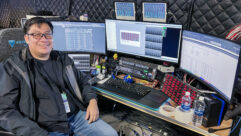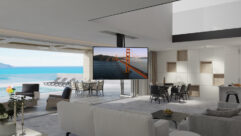
Installation Profile: Green Sanctuaries
Jan 4, 2008 12:00 PM,
By Dan Daley
Houses of worship embrace environmentally friendly design.
Sidebars

Illinois megachurch Willow Creek practices “daylighting,” which uses natural light from large windows overlooking the gardens to save on energy costs and to reinforce an awareness of natural surroundings. Automated drapes coordinated with the projection system provide proper ambient-light conditions for video. Smaller churches are beginning to use similar green techniques.
For reasons both spiritual and practical, the intensely renewed focus on earth-friendly and energy-efficient approaches to life and the buildings that life inhabits have found a particularly receptive audience in the house-of-worship sector. Particularly in Christian circles, the notion of environmental concern has become current and widely accepted. The trend is manifesting itself both in the construction of houses of worship and in the AV systems these churches choose to install.
Drawing on Christian metaphor to make a point, Bob Adams, director of business development and marketing at J.H. Batten, a Walkerstown, N.C.-based design-build general contractor specializing in church and religious facility construction, encourages churches to “get their house in order.” “[Churches have] to become energy-sustaining and sustainability examples, not only of the ministries the people do, but also of the facilities they have,” he says. “Church buildings stand for something. … To put it simply, if we are efficient in the use of our resources, we can be more effective in our ministry endeavors.”
Adams is on a mission, addressing church groups around the country on green architecture, but he also has concrete examples of how installed systems fit into the proposition. Citing the 7,200-seat Willow Creek megachurch in Barrington, Ill., Adams points out that the huge glass walls that look out on a garden on either side of the stage are an example of “daylighting” — the use of natural light to save on energy costs and to reinforce an awareness of natural surroundings. “It’s lovely, but the video guys hate stuff like that. It’s completely at odds with what they need to make the displays perform optimally,” he says.
The solution in this case was the addition of automated drapes coordinated with the projection system that cover the windows in less than 10 seconds. Adams says that technology advances make automated solutions such as these available even for churches that don’t have Willow Creek’s $80 million annual budget.
“We recently did a church renovation where the AV subcontractor we used specified LED lighting instead of incandescent or halogen,” he says. “That alone allowed us to reduce the load on the air conditioning by 7 tons.”
Adams evangelizes the use of new technology for its energy efficiency and its cost-effectiveness. “Typically, anything older than five years old will be less efficient than anything newer, when it comes to technology,” Adams says, adding that this should be a crucial argument used by AV integrators as they discuss upgrades with house-of-worship clients. “Replacing more equipment than they might have originally envisioned seems like it’s running up the costs. But the reality is if the new equipment is more efficient, it’s going to recoup the costs of that new technology faster.”
TURN OFF, TURN ON
Green construction can be significantly interwoven with technology systems in various ways. One of the most obvious ways lies in minimizing power consumption simply by turning equipment off when it’s not in use. That is a method that Bill Thrasher, owner of the Thrasher Design Group in Kennesaw, Ga., acknowledges is just getting its due in church-systems design.
“Back when I used to work at Disney, everything was always on, all the time,” Thrasher says. “Most people felt that constantly cycling electrical equipment would shorten its lifespan. That was true to a large extent when AV technology used a lot of vacuum tubes, including CRTs, as well as metal halide and other arc-type lighting. Today, solid-state electronics, plasma, and LED displays — and newer technology like switch-mode amplifiers that generate less heat — are far more forgiving about being regularly cycled and have a greater mean time before failure.”
For instance, in a recent AV systems design for a new addition to the First Baptist Church in Hendersonville, Tenn. — a facility that is using geothermal water for heating and cooling the church — Thrasher for the first time specified (in collaboration with Baker Audio of Atlanta, which did the install work) the programmable aspect of Extron’s IP-Link serial-control system to schedule systems cycling. That simply means automatically turning off sound and video systems during periods of regular non-use, such as turning off all video monitors in the AV control room overnight.
Thrasher says the move was prompted by a desire to extend the lifespan of the equipment, part of the ROI analysis in a design-build proposition. But the collateral benefit is improved energy efficiency. “And that’s something else that ultimately helps the bottom line,” he says.
The church’s new geothermal heating and cooling system consists of 154 wells sunk 300ft. into the church’s parking lot. The wells circulate ground water — which is naturally kept between 60 degrees and 95 degrees by the Earth’s heat — into the structure to either warm the building, or cool it by removing heat and dissipating it into the ground.
Daryl Etheridge, project manager for the general contractor, Nashville-based Hardaway Construction, says the ROI on the system will take seven to eight years. Bill Swift, vice president of system installer KLM Mechanical, also in Nashville, says that return is enhanced by the fact that the geothermal system eliminates the need for cooling towers and boilers, and by the centralized HVAC control it provides using a proprietary system from local company Thermatech.
“It’s the same system that the church uses to do things like turn on exterior lighting and pre-heat or pre-cool the sanctuary,” Swift says. “Individual energy-saving systems like geothermal heating and cooling are wonderful, but the real benefit comes from synergizing them with integrated control systems.”
Installation Profile: Green Sanctuaries
Jan 4, 2008 12:00 PM,
By Dan Daley
Houses of worship embrace environmentally friendly design.
ROLE OF THE INTEGRATOR
Integrators are increasingly incorporating the notion of energy efficiency into their presentations to house-of-worship clients. Van Sachs, a partner in Signature Light and Sound in Charlotte, N.C., says recommendations about products such as LED lighting, made in the context of both performance and energy efficiency, have begun to resonate with house-of-worship clients in recent years.
“When you explain how LED lights are more efficient — they don’t generate as much heat, they have lower power consumption, and the [lighting elements] last longer — and use that information to frame how the church will save money over the long run, that’s become very important,” he says.
The energy efficiency of a project is benefitted by bringing an AV integrator into the picture as early as possible. Acoustical treatment and thermal insulation can be synergized, for example, and the specification of electronics may be initially more expensive but less costly to operate over the long term. “If you can plug the [AV] numbers into the larger budget equation, you’re doing yourself and them a favor,” Sachs says.
The green trend is nascent, but it will spread quickly in the house-of-worship sector, says Hector La Torre, managing partner at Fits & Starts Productions, a south New Jersey firm whose Church Sound Workshops provide technical training for houses of worship nationally.
In mid-2008, the company is slated to launch Go Green Express, a mobile classroom funded by sponsorships and state grants and designed to bring environmental and energy-conservation messages to schools and churches via their youth ministries. La Torre is optimistic that churches will increase their green factor in coming months, and he points out that many churches are already passively participating in conservation.
“Churches are big users of audio, video, and computer technology, and that technology has been quickly eliminating the use of lead in its products,” La Torre says, citing the removal of lead from solder, integrated circuit boards, and batteries. “We’ve been pointing that out in our Church Sound Seminars, explaining that it’s an example of the many and varied ways that houses of worship can go green. It’s not all geothermal and solar panels, although those are great.”
As houses of worship become larger users of media technology, the prospects for systems designers and integrators to work with them to make that technology more energy efficient will increase. It could be an economic opportunity, but more importantly, it could become a way to deepen the relationship between the integrator and the house of worship.
“There are people out there who see this as a chance to sell more to churches — that ‘going green means getting green,’ as some people put it,” La Torre says. “But there’s another way to look at it: ‘Doing well by doing good.’”
Dan Daleyis a veteran freelance journalist and author specializing in media and entertainment technology and business sectors. He lives in New York, Miami, and Nashville, Tenn., and can be reached at[email protected].
LEED Certification
Matt Baker, project estimator and manager at Parkway Electric in Holland, Mich., recently became LEED-certified. It’s a relatively simple process — a few courses and an exam administered by the U.S. Green Building Council for less than $1,000, but it’s one that has an increasing allure to clients, including churches. The LEED-certified, accredited professional becomes the green coordinator on projects, filling out ongoing paperwork, which is submitted to the Green Building Council to confirm that various aspects of the construction conform to LEED parameters.
“The biggest change is that systems installers who want to be LEED-certified have to interact with other construction trades much earlier in the process,” Baker says. “It’s all about managing heat exchange — how many BTUs is something like a lighting system going to add to the end result?”
Baker says that churches are just becoming aware of LEED certification as an advantage, and he says when more begin to implement the standards, it will cause a ripple effect in communities. “Churches are bellwethers of their communities,” he says. “When churches do it, you’ll see school and theater and other facilities follow suit. That’s important for installers to be aware of.”
— D.D.
Learn more about LEED certification at svconline.com/flatscreens/features/avinstall_going_green.
Pitching Energy Efficiency
Some points to keep in mind when bringing up the topic of energy efficiency with a house-of-worship client:
- Green is not a gimmick Religious organizations are taking energy conservation very seriously. Issues such as global warming are no longer the political and ideological footballs they once were. Research and make a professional commitment to the concept yourself before using it as a selling point.
- Have data ready There are numerous resources to help you determine what the conservation benefits of any installation can be. These can be provided by local utilities, various government agencies, or private companies on the Web. For instance, at eere.energy.gov/buildings/info/documents/pdfs/ssl_final_report3.pdf, you will find a calculator for determining energy savings for solid-state (LED) lighting; at pmdb.cadmusdev.com/powermanagement/quickCalc.html is a calculator for estimating energy savings for computer power management. Don’t just tell house-of-worship clients that green is cost-effective — show them.
- Offer to audit Local utilities also may offer free or low-cost audits for houses of worship. They can become an ally in the process of offering turnkey green service.
— D.D.
Let There Be Light
The green movement in the house-of-worship domain is more evolved than many realize. Just how evolved is demonstrated by the existence of the Massachusetts Interfaith Power & Light (MIP&L), a nonprofit initiative offering Massachusetts congregations of every religious persuasion a means of reducing energy consumption, lowering operating costs, and promoting renewable energy in houses of worship and related buildings. The organization’s website (www.mipandl.org) defines the initiative as “a mutual ministry working with the community of faith toward environmental justice and care of creation.”
Membership fees are on a sliding scale based on annual operating costs, starting at $50 for an operating budget up to $150,000. Membership includes benefits such as the option to join an oil-purchasing group that can lock in prices based on oil futures, utility rebate programs, energy-oriented capital needs assessments, and access to technical advice on energy issues. For a relatively low additional fee, also on a sliding scale, MIP&L offers a comprehensive energy audit of worship facilities followed up by its Environmental Stewardship Report, which presents findings and recommendations for future energy-conservation measures tailored to that facility.
— D.D.










